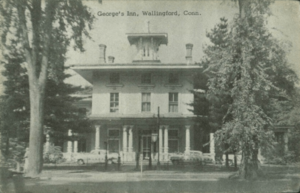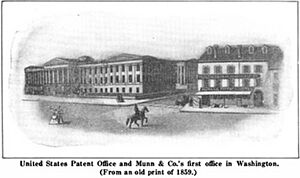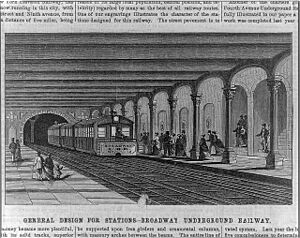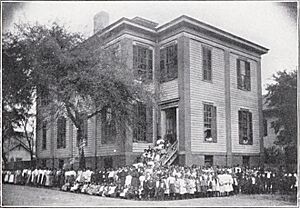Alfred Ely Beach facts for kids
Quick facts for kids
Alfred Ely Beach
|
|
|---|---|
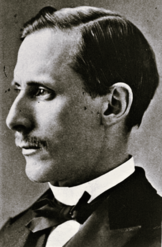
Beach c. 1870
|
|
| Born | September 1, 1826 |
| Died | January 1, 1896 (aged 69) New York City, US
|
| Education | Monson Academy (now Wilbraham & Monson Academy) |
| Occupation |
|
| Known for | Designing the Beach Pneumatic Transit |
| Children | Frederick Converse Beach |
| Parent(s) |
|
| Relatives | Moses S. Beach, brother William Yale Beach, brother Charles Yale Beach, nephew Stanley Yale Beach, grandson |
| Family | Yale |
Alfred Ely Beach (September 1, 1826 – January 1, 1896) was an American inventor, business owner, publisher, and patent lawyer. He was born in Springfield, Massachusetts. Beach is famous for designing the very first subway in America, called the Beach Pneumatic Transit, which was a predecessor to the New York City Subway.
He was also an early owner and co-founder of Scientific American magazine and Munn & Co. This company was the country's top agency for getting patents. Beach helped famous inventors like Thomas Edison, Alexander Graham Bell, and Cornelius Vanderbilt get patents for their new ideas. He also invented a special typewriter for people who were blind and a way to heat water using solar power.
Contents
Alfred Beach's Early Life
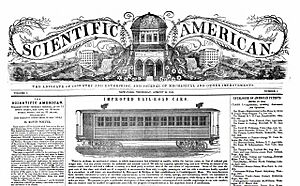
Alfred Beach grew up in Springfield, Massachusetts. His father, Moses Yale Beach, was a well-known publisher who owned the New York Sun newspaper.
Alfred worked for his father's newspaper for a while. Later, he and his friend, Orson Desaix Munn, decided to buy Scientific American. This was a new magazine at the time. They became the first owners of the company. Beach was the editor and publisher of Scientific American for fifty years. The magazine is now the oldest continuously published magazine in the United States. It has featured articles by famous scientists like Albert Einstein and Marie Curie.
Munn & Co.: Helping Inventors
In 1846, Beach and Munn started a patent agency called Munn & Co. It was part of Scientific American magazine. This agency helped scientists and inventors get patents for their new ideas. They helped with the paperwork and tracked the patent applications at the U.S. Patent Office. Their office was right next door to the Patent Office in Washington.
A young Thomas Edison often visited Beach's office. One day, Edison showed Beach his new invention, the phonograph. Beach liked it and helped Edison get a patent for it. Edison became a frequent visitor.
Munn & Co. also helped many other inventors. These included Alexander Graham Bell (who invented the telephone) and Samuel F. B. Morse (who invented the telegraph). The agency helped thousands of inventors get patents. At its busiest, Munn & Co. helped with about three thousand patents each year.
Beach also patented some of his own inventions. One important invention was an early typewriter made for blind people. This was a first for the Americas. He won a gold medal for it in 1853. This typewriter became a model for others for many years. He also invented a special machine called a tunnelling shield. This machine helped dig tunnels underground.
His patent agency and magazine became very successful. They helped new technologies grow in the 1800s. Munn & Co. handled about one-third of all patents issued by the U.S. Patent Office.
Building New York's First Subway
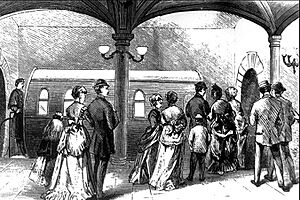
Beach's most famous invention was New York City's first subway, the Beach Pneumatic Transit. He got permission to build it in 1868. Beach created his own company, the Beach Pneumatic Transit Company, and became its President.
He got the idea in the late 1860s because traffic in New York City was terrible. Most people traveled by walking or in horse carriages, especially on Broadway. Beach wanted to build an underground railway to ease the traffic. He was inspired by London's underground railway. But instead of steam trains, Beach wanted to use trains pushed by air, using pneumatics. He also planned to use his special tunnelling shield to dig the tunnel without disturbing the street much.
Beach's tunneling shield was round, unlike earlier square designs. It was one of the first round tunnel designs used in America.
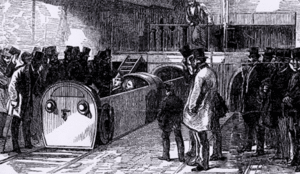
Beach was also interested in using pneumatic tubes to send letters and packages. This idea was already being used in London.
New York City's government at the time was known for being corrupt. Beach decided to build his subway in secret to avoid problems with these officials. He used $350,000 of his own money for the project. He hoped that once the public saw the subway, politicians wouldn't dare to stop him.
He started building a tunnel for small pneumatic tubes in 1869. But he changed his plan to make it a demonstration passenger railway. It opened on February 26, 1870. This was New York City's first underground subway.
The demonstration railway was a big success. In less than a year, 400,000 people used Beach's underground system. He wanted to extend the line to Central Park.
Why the Subway Project Stopped
In 1870, a state senator tried to pass a bill to fund Beach's subway, but it didn't pass. Some powerful property owners along Broadway, like Alexander Turney Stewart and John Jacob Astor III, were against the subway. They worried that digging tunnels would damage buildings and make surface traffic worse.
Bills for Beach's subway passed the state legislature in 1871 and 1872. However, the Governor, John T. Hoffman, stopped them. He said the bills gave too much power without enough benefit to the city or state. In 1873, a similar bill was finally signed into law. But then a financial crisis, the Panic of 1873, made it impossible for Beach to raise money for the project.
During this time, other investors built an elevated railway (a train above ground) that worked well. This made elevated railways seem more practical than underground ones for New York City at the time.
Beach's demonstration subway ran from February 1870 to April 1873. It had one station in the basement of a clothing store. The station was very fancy, with chandeliers, mirrors, a fountain, paintings, and a piano. Beach spent $70,000 of his own money to make it luxurious.
When the subway closed, the tunnel space was used for other things, like a wine cellar and a storage vault. Beach gave the money he made from the subway to charities, like a home for orphans of soldiers and sailors.
In 1912, workers digging for a new subway line discovered Beach's old tunnel and station. They also found his old tunnelling shield and parts of the original subway car.
Beach's Ideas for Mail Service
Legacy of Alfred Ely Beach

Beach's Tunnelling shield design was later used in other big projects. These included Canada's first St. Clair Tunnel and underground railway tunnels in London and Glasgow.
His pneumatic system was the first air-powered train in America. This idea of using air to move trains has been explored again recently by people like Elon Musk with his Hyperloop concept.
After the American Civil War, Beach founded a school for newly freed African Americans in Savannah, Georgia. This school, called the Beach Institute, was the first school in Savannah built specifically for the education of African Americans.
Beach was also a member of the Union League Club of New York. This group supported the policies of Abraham Lincoln and was against slavery.
Pneumatic tubes, like the ones Beach used, are still used today in some places, such as banks and the CIA headquarters. Less than ten years after Beach's death, New York City built its first modern subway system in 1904. Beach is remembered in the history of the New York City Subway.
Alfred Ely Beach died on January 1, 1896, at the age of 69.
His son, Frederick Converse Beach, took over Scientific American magazine. His grandson, Stanley Yale Beach, also worked for the magazine and was an early supporter of aviation pioneers.
See Also
Images for kids


